Women: Living in the Province of Roman Britain

Introduction
This lesson looks at some different types of surviving evidence which tells us something about the lives of real Roman women who lived in the province of Britain between the 1st and 4th centuries AD. The carved stone female head (above) was found in Towcester in Northamptonshire and is thought to have come from a funerary monument. It is on display in the British Museum.
The information on this page and the associated resources was created by Jacqui Butler, PhD student here at the University of Warwick. Jacqui is currently working on Images of female mythological sacrificial characters and the role of the feminine in Roman art.
Sources of evidence
There are four main sources of evidence covered in this section.
- Funerary monuments: these give information about both the people they commemorate and those who set them up.
- Writing tablets: these are amazing artefacts to have survived, and this lesson looks at some examples from Vindolanda, at Hadrian’s Wall.
- Jewellery: another type of archaeological evidence that tends to have survived well; this section also includes some other objects related to personal adornment which women would have worn.
- Votive offerings: these are objects that people dedicated to gods and placed in temples or sanctuaries.
Funerary monuments
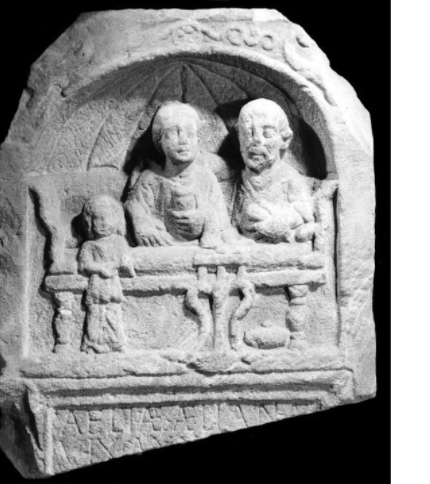
Funerary monuments survive in abundance from the ancient world and are widely found in from the time period of Roman Britain. They range from simple stone markers to elaborate sarcophagi, and they differ in size and the materials they are made from, due to the wealth of the person who commissioned them. Sometimes they are simple markers with text which commemorates the deceased in Latin.
The Romans introduced writing (and Latin) to Britain – the native inhabitants did not record their (Celtic) language(s) in writing before the Romans arrival, although there are some Iron Age coins which carry words in Latin or Greek.
Inscriptions include a lot of abbreviations, and this was partly because both marble and carving on it was expensive, so inscriptions were carefully considered by the person setting them up as regards the cost and what they wanted to convey. By using standardised abbreviations, it allowed people to communicate messages through a type of code, and although many people could not read, they would have recognised certain letters together
Quite often funerary monuments combine text with images carved into the stone and these give a more immediate visual impression and are often highly informative.
The tombstone here (left) is that of Aelia Aeliana, now on display at York Museum (No. YORYM : 2010.43).
So what can these tell us?
The combination of images and text reveal a variety of interesting things about how people wanted to be represented, or perhaps more accurately, what the person commissioning the monument wants them to be remembered for. So funerary monuments were a means of projecting ideas of individual identity, and this can be seen in the images chosen, and also in how the people are depicted. This can include dress, for example wearing the toga signified Roman citizenship, so men are often depicted wearing this to make this visual association.
For women, often there are indicators of being virtuous or domestically capable and these are shown by the inclusion of objects related to domesticity such as baskets of wool. Wealth and status can also be indicated by the wearing of jewellery too.
In the following sections we will look at three different funerary monuments – the first two commemorate women names Julia Velva and Flavia Augustina, and the third is one which was set up by Julia Pacata.
Julia Velva
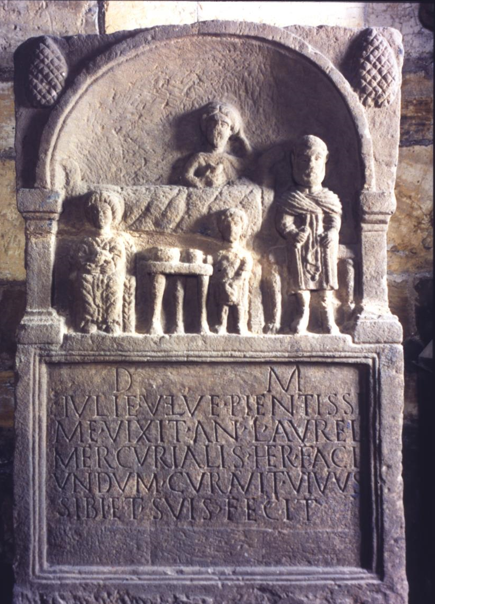 This is a gritstone (a type of sandstone) monument with a relief image and epitaph carved into it, which was found in York and is now in the Yorkshire Museum.
This is a gritstone (a type of sandstone) monument with a relief image and epitaph carved into it, which was found in York and is now in the Yorkshire Museum.
What can be picked out from the image?
The carving has an architectural type of frame which is quite common for funerary reliefs, with a round niche in which the figures are placed, and there are 2 pinecones decorating the top two corners. Pinecones may have been associated with religious ritual, and were also seen as fertility symbols, but they might also represent spiritual ideas about death, as although pinecones fall from evergreen trees, they contain seeds to create a new tree.
The image shows a feast with food set out on a three-legged table. Julia Velva is probably meant to be seen as reclining on a couch as this was a common scene on funerary monuments, but here she looks more to be standing behind it. She is holding a cup in her hand, and her hair is simply styled with a centre parting.
The inscription tells us that she was aged 50 when she died and also names her heir Merculialis. She was obviously not his mother, or this would have been mentioned in the inscription, but she may have been his mother-in-law. Merculialis stands at the front and appears to be the most prominent figure and this ties in with it being him who commissioned the tomb.
This gives the impression that he was perhaps trying to commemorate himself perhaps more than Julia Velva, as the inscription also says that he has set up the tomb for himself and his family. He is wearing a tunic, cloak and boots and is holding a scroll in his hand which is supposed to be her will.
On the left is a female figure seated in a wicker chair holding a bird, and there is another young girl, probably an attendant, holding a jug. Literary sources suggest that women quite commonly kept pets for companionship and birds in particular were popular pets for women, especially songbirds.
Flavia Augustina
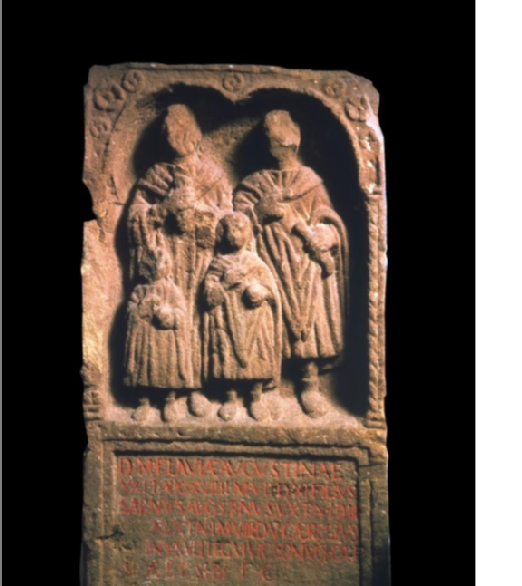
What can be seen in this tombstone, which is also from York?
It shows a family group of four and tells a sad story.
We have the two parents standing at the back: Flavia Augustina and her husband Gaius Aeresius Saenus who was a military veteran; together with their two children standing in front of them. Both adults are shown holding scrolls, while the children are holding balls – popular toys for simple children’s games. Their dress is very similar and is probably showing a type of dress that was less Roman and more Celtic, and it appears to be quite heavy looking which would make sense given the climate conditions in northern England.
The children are depicted as mini versions of their parents, although their portrayals show them as older than they were when they died. This again is quite common on Roman funerary monuments and is really quite poignant, as it shows more what the children may have grown up to become rather than how they were when they died.
The tombstone tells the sad story that Saenus had lost not only his wife but also that he and Flavia had lost both their children aged under two years old. Infant mortality was a fact of life in Roman times but heart-breaking regardless. Saenus describes Flavia Augustina as his “beloved wife” (although care has to be taken here in presuming too much in terms of their relationship as the language used on epitaphs was vry formulaic, although that is not to say they did not have a loving relationship!)
Julia Pacata
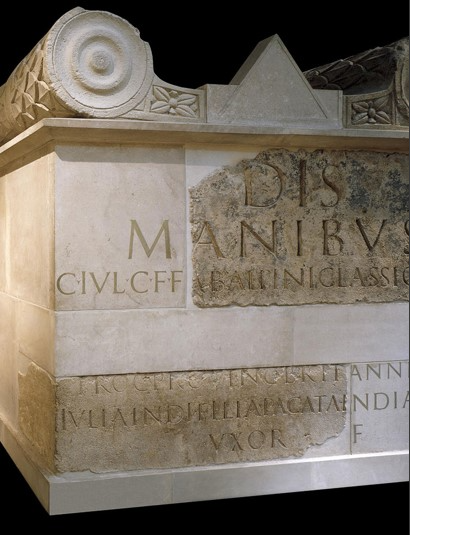
The third memorial is an altar-shaped one with decorative scrolls on top which was commissioned by a woman, Julia Pacata. There is no image on this one, and it has been reconstructed from fragments, but both the stone (oolite) and the inscription are of high quality. The fragments had been re-used in the 4th century AD but were found in London in 1852 and 1935 and pieced together, and it is now in the British Museum.
Who does it commemorate?
Gaius Julius Alpinus Classicianus: his name (Alpinus) indicates that he was a member of the elite in Gaul and he was of the equestrian rank (the second of the property-owning classes of Roman society, below the highest senatorial class).
He was appointed as the procurator (in charge of financial administration) in AD61 by the emperor Nero (ruled AD54-68) to correct the financial abuses that had been partly to blame for the British rebellion and revolt led by Boudicca of the Iceni tribe in AD60-61.
He died fairly soon after, sometime around AD64-65, as he died while still procurator and this is a role he would only have held for 3-4 years. The Roman author Tacitus talks about him, and it is unusual to be able to link a real documented person to a funerary monument.
Who was Julia Pacata?
She identifies herself as the “daughter of Indus”, and this is understood to be Julius Indus who was a pro-Roman leader of the Treveri tribe in Gaul.
Her marriage to Classicianus is likely to have been a political alliance, and via this she became part of the Roman equestrian class and Classicianus’ prestigious position in the provincial administration of Britain would have enhanced their status. Certainly, if Classicianus was procurator for around three years before he died, this would have given the couple time to establish themselves in London (which was probably acting as the capital of the province at this time). They may well have had children, although there is no record of this and we don’t know what happened to Julia Pacata after Classicianus’ death, she may have returned to Gaul.
One last thing here, can you see that in the last line of the inscription the word “VXOR” which is “uxor” is a bit larger than the lines above? This word means “wife” and it would appear that Julia Pacata wanted to emphasise this status by making the word stand out a bit more than the rest of the text. She obviously wanted to make sure that anyone reading the inscription would see that it had been set up by Classicanius’ wife, suggesting that she had some ideas about her identity and how she wanted to project this.
Writing tablets

Wooden writing tablets were used widely throughout the Roman world, and they were rectangular in shape and roughly the size of a postcard. The tablets on the right are from Vindolanda, and are now housed in the British Museum (No. 1989,0602.74).
There were two different types:
- Stylus/wax tablets: these had recessed panels onto which a layer of wax was added. The wax layer provided a smooth surface, and the writing was incised onto it with the point of a stylus. The wax could also be smoothed over again to allow for correction of any mistakes, and also so that the tablet could be reused. The wax rarely survives but there are some traces of it on a few tablets and also writing can sometimes be seen on those. These were often made of tree species such as silver fir and sometimes cedar, and these are not native tree species to Britain.
- Ink tablets: these are quite different to stylus/wax tablets, as they are quite thin in comparison, less than 1mm thick and they measure approximately 20cm x 9cm. A very sharp knife was used to cut the tablets from the sapwood of young trees, and there might be some similarity in the technique to that used for making veneers for furniture. There was probably then some preparation to the tablet to ensure the surface was smooth and so that it held the writing. Instead of a stylus, a pen and ink was used for the writing. Tablets were often folded together with the writing protected on the inside and in some cases the ink has offset onto the facing surfaces.
Vindolanda
In 1973, archaeologists working at Vindolanda discovered a large number of ink tablets (there are over 1000 although some are fragments). Others have been found throughout Roman Britain but not in the same quantity as those from Vindolanda. Vindolanda was a Roman garrison/fort in the first century AD and is located a mile south of Hadrian’s wall, which wasn’t built until the second century AD. It was occupied for over 300 years, and it was quite dependent on its own resources – there are a wide variety of skills documented which show it was quite self-sufficient. The ink tablets are an example of this as they were made from local wood such as birch, alder and oak.
So what does the writing on the tablets tell us? Many of them are actually letters which send greetings and maintain connections with others. This sort of correspondence was an important part of Roman culture.
However, the tablets are not just concerned with official business of political connections, they also give us an insight into other people lives, such as ordinary soldiers exchanging news, requesting presents and sending thanks. They were also used by women.
Claudia Severa
One of the most famous Vindolanda tablets is one written by Claudia Severa.
Who was she?
She was the wife of Aelius Brocchus, who was a garrison commander at another fort in northern England.
There are three examples of her corresponding with Sulpicia Lepidina, who was the wife of Vindolanda’s fort prefect, Flavius Cerialis, around 100 AD. We can safely assume that they were good friends as they were regular correspondents, and the contents of the tablets show this as well. Their correspondence also shows that Roman women travelled with their husbands and their families including children and household slaves to their military postings.
The tablet: it is a birthday party invitation! Claudia Severa writes to ask Sulpicia Lepidina to join her for her birthday celebrations. This tells us that the relationship was important to Claudia Severa, and that the day will be made much better by Sulpicia Lepidina being there.
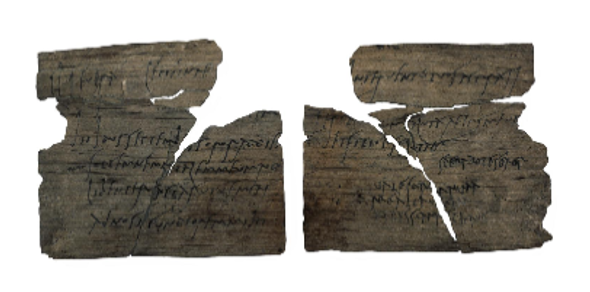 “Claudia Severa to her Lepidina greetings. On the third day before the Ides of September (11 September), sister, for the day of the celebration of my birthday, I give you a warm invitation to make sure that you come to us, to make the day more enjoyable for me by your arrival, if you are present (?). Give my greetings to your Cerialis. My Aelius and my little son send their greetings. (2nd hand) I shall expect you sister. Farewell, sister my dearest soul, as I hope to prosper, and hail.”
“Claudia Severa to her Lepidina greetings. On the third day before the Ides of September (11 September), sister, for the day of the celebration of my birthday, I give you a warm invitation to make sure that you come to us, to make the day more enjoyable for me by your arrival, if you are present (?). Give my greetings to your Cerialis. My Aelius and my little son send their greetings. (2nd hand) I shall expect you sister. Farewell, sister my dearest soul, as I hope to prosper, and hail.”
This also tells us that birthdays were cause for celebration, similar to today. Although we don’t know much about Claudia, we can surmise that Claudia was possibly in her early 20s as she has a “little son”, or she may have been younger.
The tablet is one of the earliest examples of writing by a woman in Latin. It is written in two different hands – one of which is probably a scribe as this same hand is recognisable in several other tablets. But the last few lines are written by Claudia Severa herself and although the writing is maybe not quite as neat or well-formed as that of the scribe, it does show that women did write correspondence.
Claudia Severa and Suplicia Lepidina
This second tablet is similar to the birthday party invitation, in that it is also written by a scribe and again Claudia Severa has written the final greeting.
As regards content, this one is more personal and intimate even. Claudia Severa has asked permission from her husband Brocchus to visit Sulpicia Lepidina. He has agreed and Claudia Severa outlines her intention to visit and sends her greetings to Cerialis again. The interesting thing about this one is that it hints at Claudia Severa having things she wants to talk to Sulpicia Lepidina about in person. It, as well as the birthday invitation, shows that women travelled within the province of Britain, from garrison to garrison and had active social lives, which was an important part of elite Roman society.

" ... greetings. Just as I had spoken with you, sister, and promised that I would ask Brocchus and would come to you, I asked him and he gave me the following reply, that it was always readily (?) permitted to me, together with .... to come to you in whatever way I can. For there are certain essential things which .... you will receive my letters by which you will know what I am going to do .... I was ... and will remain at Briga. Greet your Cerialis from me. (Back, 2nd hand) Farewell my sister, my dearest and most longed-for soul. (1st hand) To Sulpicia Lepidina, wife of Cerialis, from Severa, wife of Brocchus (?)." (British Museum No. 1986,1001.46).
The relationship between Claudia Severa and Sulpicia and Lepidina certainly seems likely to have been a close one and they obviously corresponded regularly and met fairly frequently as well.
What do you think life would have been like for these women living in remote garrisons in Britain? How would it have compared to living in Rome?
Jewellery/objects related to personal adornment
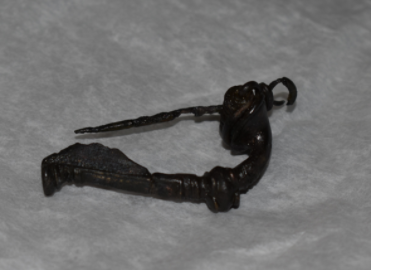
Jewellery is something that survives well due to the materials it is made from: such as precious metals and stones, gemstones, amber and jet. Necklaces were sometimes made of beads (glass of semiprecious stones) strung on leather cord. Bracelets and armbands were also common as were finger rings and earrings; anklets were also worn.
The item on the left is a Romano-British Trumpet Brooch, on display at Lunt Roman.
Other items of personal adornment such as hairpins, made from ivory or bone and brooches made from metal, also survive well and all of these inform us about the importance of female dress and adornment in Roman society.
The following section will look at an example of each of these.
Jet pendant
 This is an oval pendant made from jet and is thought to show two cupids working on a potter’s wheel. Cupids working as craftsmen is a common theme in Roman art. The pendant is on display at the British Museum (No. 1852,0626.1).
This is an oval pendant made from jet and is thought to show two cupids working on a potter’s wheel. Cupids working as craftsmen is a common theme in Roman art. The pendant is on display at the British Museum (No. 1852,0626.1).
This would have been worn around the neck, suspended from either a fabric or leather cord, or a ribbon. It would have been made in Britain and dates to sometime in the 2nd to 4th centuries AD.
Jet was used in Britain from the Neolithic period and was used in the Bronze Age for beads for necklaces before the Romans came to Britain. Jet was quite rare, probably quite expensive, and was mostly found at Whitby. There is evidence for jet working at York where beads and bracelets were made, as well as rings and pins.
Other pendants in Britain depict animals, the head of Medusa, or portraits of couples or family groups. Other objects made of jet: spindle whorls, spindles and knife handles. More commonly associated with women as most often found in female graves, so may have had some special significance – perhaps protective. However, not exclusively female as several male skeletons in Britain from the time period have also been found wearing jet items.
Gold necklace
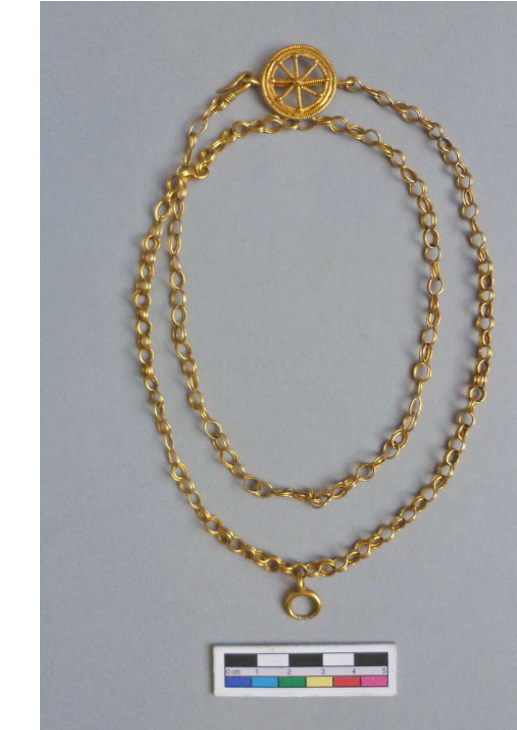 This is a gold necklace that was part of an assemblage from somewhere around Backworth, in Tyneside (Hadrian’s Wall area). (Exact provenance is unknown). The necklace is on display at the British Museum (No. 1850,0601.3). It was discovered in 1811 and acquired by the British Museum in 1850.
This is a gold necklace that was part of an assemblage from somewhere around Backworth, in Tyneside (Hadrian’s Wall area). (Exact provenance is unknown). The necklace is on display at the British Museum (No. 1850,0601.3). It was discovered in 1811 and acquired by the British Museum in 1850.
Other items included in the hoard were: 280 coins although these are all missing apart from one; a silver pan, silver spoons, a silver mirror; gold brooches; gold rings; another similarly styled gold necklace and a bracelet. It is dated to the 1st to 2nd centuries AD.
The chain part of the necklace has 72 links, which are double and shaped as a figure-of-eight. It has a wheel shaped clasp with spokes and a crescent shaped pendant at the front. The wheel shape could have associations with the Celtic sun-god Taranis. It is designed to have been worn looped twice around the wearer’s neck because the pendant is not placed exactly opposite the clasp when it is in a single loop.
Jewellery was often a part of young women’s dowries and could therefore represent some independence from male control, as dowries were not considered part of a woman’s husband’s assets under Roman law. Fine delicate jewellery such as this would have been owned and worn for purely decorative purposes by high status individuals, to demonstrate both this status and their wealth.
Alongside this there were some social tensions around adornment:
-
- Women were characterised by male authors in literary sources as desiring extravagant luxury items.
- This fed into ideas of women lacking self-control, which then also aided tensions about female modesty and sexual behaviour.
- The expense of jewellery and other luxury items was considered wasteful.
- Women being overly concerned with their appearance were considered frivolous.
Hairpins
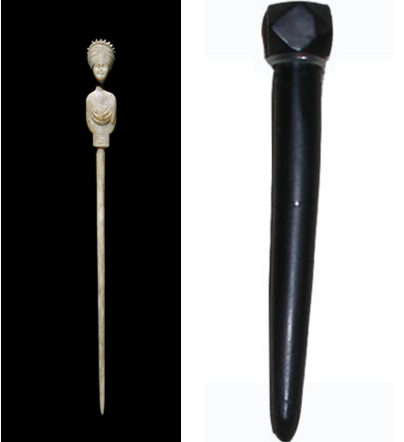 Hairpins are quite interesting objects because as you can see they come in quite diverse shapes, sizes and materials. The hairpin on the far left is a bone hairpin which measures 195 mm (British Museum No. OA.245). Near left is a Jet hairpin measuring 55mm (British Museum No. 1866,1203.109).
Hairpins are quite interesting objects because as you can see they come in quite diverse shapes, sizes and materials. The hairpin on the far left is a bone hairpin which measures 195 mm (British Museum No. OA.245). Near left is a Jet hairpin measuring 55mm (British Museum No. 1866,1203.109).
They were usually made from bone or ivory, but sometimes more exotic materials, including precious metals, rock crystal and even jet. They are quite common finds especially from bath-houses.
The measurements of these two hairpins show how different these could be. The jet one is quite short and the faceted head of it measures 8mm, while the tip is just 2mm, and it dates to around the 4th century AD. The bone one is much longer at 195 mm and dates to the late 1st century AD. It is beautifully carved with the bust of a woman with an elaborate hairstyle and diadem.
Roman hairstyles for women changed over time and certain styles went in and out of fashion much as today, and women also dyed their hair. Elite women would have had slaves to dress their hair into elaborate styles and also used false hairpieces to supplement these.
As well as pins, they also used gemstones to ornament their hair as well as golden hairnets (you can see these on some fresco images from Pompeii, but these went out of fashion after the 1st century AD). Longer pins, like the bone one, were needed for the more intricate hairstyles, while simpler styles would have used the shorter pins like the jet one. Poorer women may have used wooden pins to dress their hair.
Brooches
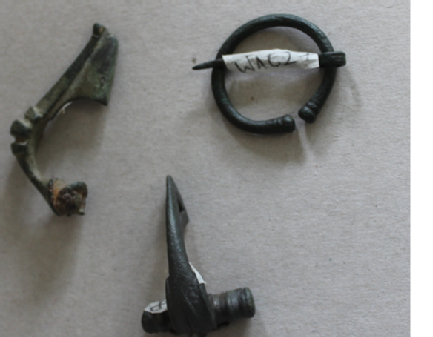
Brooches were very functional items as they were used to pin or hold clothing together or keep it in place. They were made in a variety of different shapes and sizes and worn by both men and women. They could be very plain or highly decorative, be made from precious metals and have jewels set into them.
You can see examples of them on funerary monuments and also statues. Go back and see if you can see any on the slides on funerary monuments at the beginning of the page.
The ones pictured here are from the collection of the Department of Classics and Ancient History at the University of Warwick and these are made from bronze and the two trumpet shaped ones are missing their pins.
What do you think it would have been like to wear these?
Votive objects
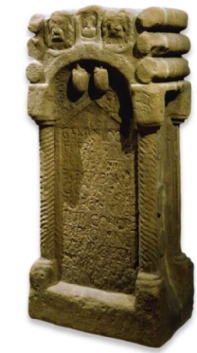 What were these?
What were these?
A variety of objects which were dedicated either to a single god (often Mars at Hadrian’s Wall sites) or to multiple gods and these were dedicated either by individuals or sometimes groups of individuals (e.g. cohorts from provinces or family groups).
Inscriptions tell us who the objects were dedicated to and who dedicated them. Right is one such votive from the British Museum (British Museum No. 1969,0701.3).
Most often the objects which have inscriptions are: altars; statuettes and leaves or plaques. These would have been set up within temples or placed within the precincts of temples.
Other objects were also dedicated to deities without the expense of an inscription, and these can be simple everyday objects such as pottery. They can also be quite obscure items – for example a tin canister of face cream! (For more on this, visit Material Musings blog post dated June 2021 https://blogs.warwick.ac.uk/materialmusings/monthly/0621/)
Votive plaque
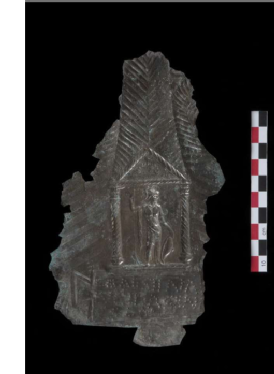 This is a silver plaque which is a very thin sheet of silver which has been embossed and incised with imagery and decoration and also a punch dot inscription in Latin.
This is a silver plaque which is a very thin sheet of silver which has been embossed and incised with imagery and decoration and also a punch dot inscription in Latin.
It is part of the Ashwell Hoard which was found by a metal detectorist in Hertfordshire in 2002 and is now on display in Gallery 49 of the British Museum (British Museum No. 2003,0901.16). The hoard is comprised of 20 votive leaves in silver and gold, jewellery and a silver statuette and base.
The Ashwell Hoard was a really important find because it introduced a new deity – the goddess Senuna – who had not been known of before this hoard was found.
Senuna is thought to potentially have been a local deity connected to water and was connected to Roman Minerva. There was a river named Senua somewhere in southern England.
So the image we can see on this plaque is Minerva, and you can see she is wearing a crested helmet and holding a spear and these are her usual attributes. The punch dot inscription can be seen underneath.
The inscription tells us that the plaque was dedicated by a woman named Lucilia Sena, but unfortunately, we don’t know anything more about her.
Votive figurine
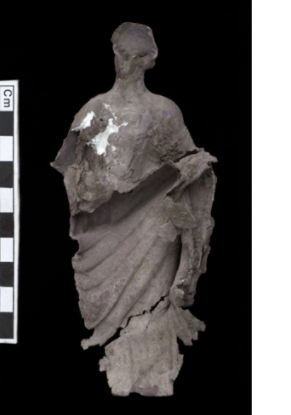
Another object from the Ashwell Hoard, and this is a silver hollow figurine or statuette, which has been quite badly damaged, although it would have been of high quality originally.
It is the figure of a woman (left), wearing a full-length garment.
It was dedicated to Senuna again, and we know this because the inscribed base for the statuette was found separately, and although it is not shown here, it is in the same case as the statuette in the museum. It’s likely that the figurine is an image of Senuna, and it was dedicated by a woman named Flavia Cunoris in fulfilment of a vow. Lucilia Sena also dedicated the silver votive plaque in fulfilment of a vow.
This was part of the reciprocal relationship between the dedicant and the deity. People would ask a deity for help or protection and would promise (via making a vow) to make a dedication (usually an object) to the deity in return for their assistance.
So it’s possible to understand that both Flavia Cunoris and Lucilia Sena had this relationship with Senuna and their dedications to her, which would have originally been set up within the temple, would have been visible to anyone visiting the temple. They were obviously both quite wealthy and the dedications would have probably functioned to both demonstrate this and also enhance the status of the women in their community.
